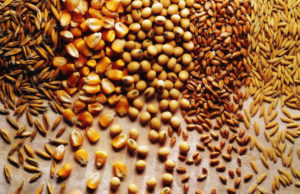 Grain futures advanced on Thursday, wheat jumped to the strongest level in 4-1/2 months on speculation that escalating tension in Ukraine may disrupt the countrys exports and buyers may shift purchases to other countries, including the US.
Grain futures advanced on Thursday, wheat jumped to the strongest level in 4-1/2 months on speculation that escalating tension in Ukraine may disrupt the countrys exports and buyers may shift purchases to other countries, including the US.
On the Chicago Board of Trade, wheat futures for settlement in May rose by 0.51% to trade at $6.8788 per bushel by 12:35 GMT. Prices touched a session high of $6.9625 per bushel, the strongest since October 25, while day’s bottom was touched at $6.8225 a bushel.
Wheat settled 8.2% up in February, after plunging 8.3% in January and 9.5% in December, on expectations for a record global output of 712.7 million tons.
According to data by the International Grains Council (IGC), Ukraine will be the sixth-largest global wheat exporter, as it is forecast to ship 9.5 million metric tons of the grain in the 2013-14 season through June, up from 7.1 million tons a year ago.
At the same time, the parliament of the southern Ukrainian region, Crimea voted on Tuesday that the Black Sea peninsula will declare itself an independent state if its residents approve a March 16 referendum on splitting from Ukraine and joining the Russian Federation as Western leaders threaten sanctions. Yesterday, the US President Barack Obama assured the Ukrainian Prime Minister Arseniy Yatsenyuk that the US will stood with Ukraine to protect its sovereignty and territorial integrity.
“Grain traders are still focusing their attention on developments in Crimea,” Carsten Fritsch, an analyst at Commerzbank AG in Frankfurt, said in a Bloomberg interview. “In the event of a yes vote, shipment problems could be the result.”
Data by the US Department of Agriculture showed that as of the period ended February 27th, US exporters sold 556 072 tons of wheat for delivery this marketing year, up more than 50% from a week ago. The US is the largest exporter of the grain in in the world, also according to data by the USDA.
DTN’s March 12th forecast called for a storm system to bring snow and rain over the eastern Midwest and to continue delay the start of the spring fieldwork. According to the website, the soil moisture for red winter wheat is adequate at the moment. The seven-to-ten days time period continues with manly below-normal temperatures and slow warming of soils. At the same time, western Midwest have a more beneficial temperature pattern, but lack soil moisture in many places.
Meanwhile, limited rainfall is expected across the dry areas of the southwestern Plains during the next 10 days. On Tuesday, wind blasts reached 45-50 mile per hour. Concern over crops started to increase as the spring season is nearing and for now, there are no signs of improving amounts of rainfall. The weather pattern may change somewhat later in March, but for now signs are not convincing enough.
Corn edges slightly higher
On the Chicago Board of Trade, corn futures for May delivery rose by 0.1% to trade at $4.8963 a bushel by 12:38 GMT. Futures hit a session high at $4.9338 per bushel, while day’s low was touched at $4.8662 per bushel. On March 7th, corn futures touched $5.0238 per bushel, the strongest since August 27 and capped a 5.3% weekly gain, the biggest advance since the period ended May 31.
Corn has surged 14% this year after the escalating tension between Ukraine and the Russian Federation threatened to disrupt shipments from the Black Sea region. The grain plunged nearly 40% in 2013, the steepest annual drop on record and the worst annual performance since at least 1959.
DTN.com reported on March 12th that soil moisture for second crop corn and late-filling early soybeans and corn in central Brazil is adequate to surplus at the moment.
Meanwhile, the website reported that conditions in central Argentina continue to be mostly favorable for filling and maturing corn and soybeans at this time. Scattered thundershowers are expected at the end of this week, recharging soil moisture, but also being unfavorable for early-maturing crops.
Soybeans up as well
On the Chicago Board of Trade, soybeans futures for settlement in May, rose by 0.1% to trade at $13.8838 per bushel by 12:40 GMT. Futures touched a session high at $13.9588 per bushel, while day’s low was hit at $13.8088 per bushel. On March 7th, prices touched $14.5962 per bushel, the strongest since July 24th.
The grain settled last week 3.2% higher, after adding 3.1% in the previous 5-day period. However, the oilseed has lost 8.5% in 2013.
China has rejected 245 000 metric tons of US soybeans for delivery by August 31st, data by the US Department of Agriculture showed last week. Data also showed that as of the period ended February 27th, China imported 25.5 million metric tons of US soybeans since September 1st, nearly 70% of all shipments by the country. The US is the second largest exporter of soybeans in the world, after Brazil.
There were also growing speculations that China may have rejected more than 500 000 tons of Brazil’s soybeans, which further pressured prices.
“When you have beans at $14 a bushel, it is very hard to continue to be bullish on it,” Ole Houe, director of advisory services at Ikon Commodities Pty Ltd., said in a Bloomberg phone interview from Sydney. “The quantity of cancellations is rising by the day and that’s got everybody running scared off beans.”





